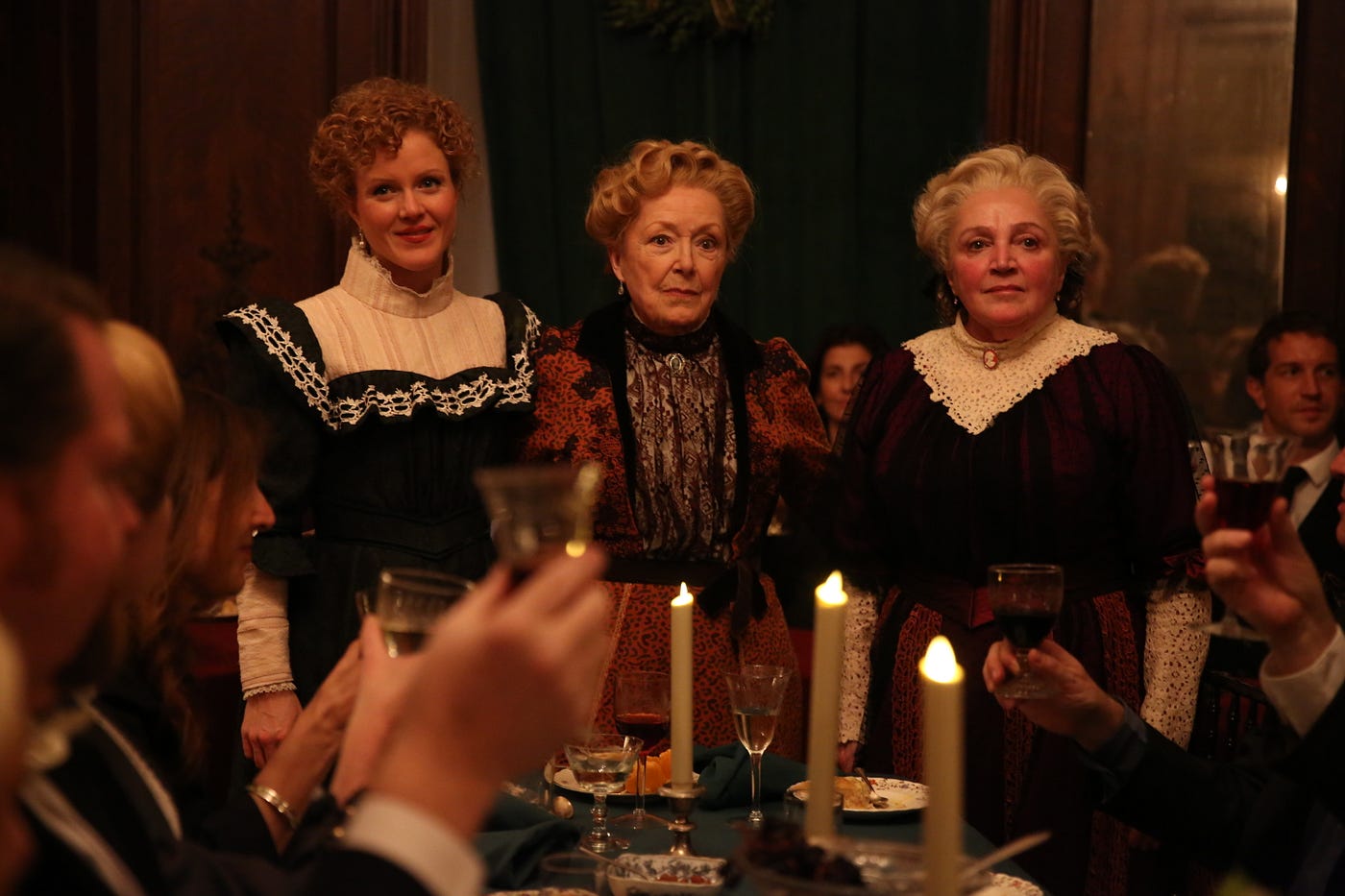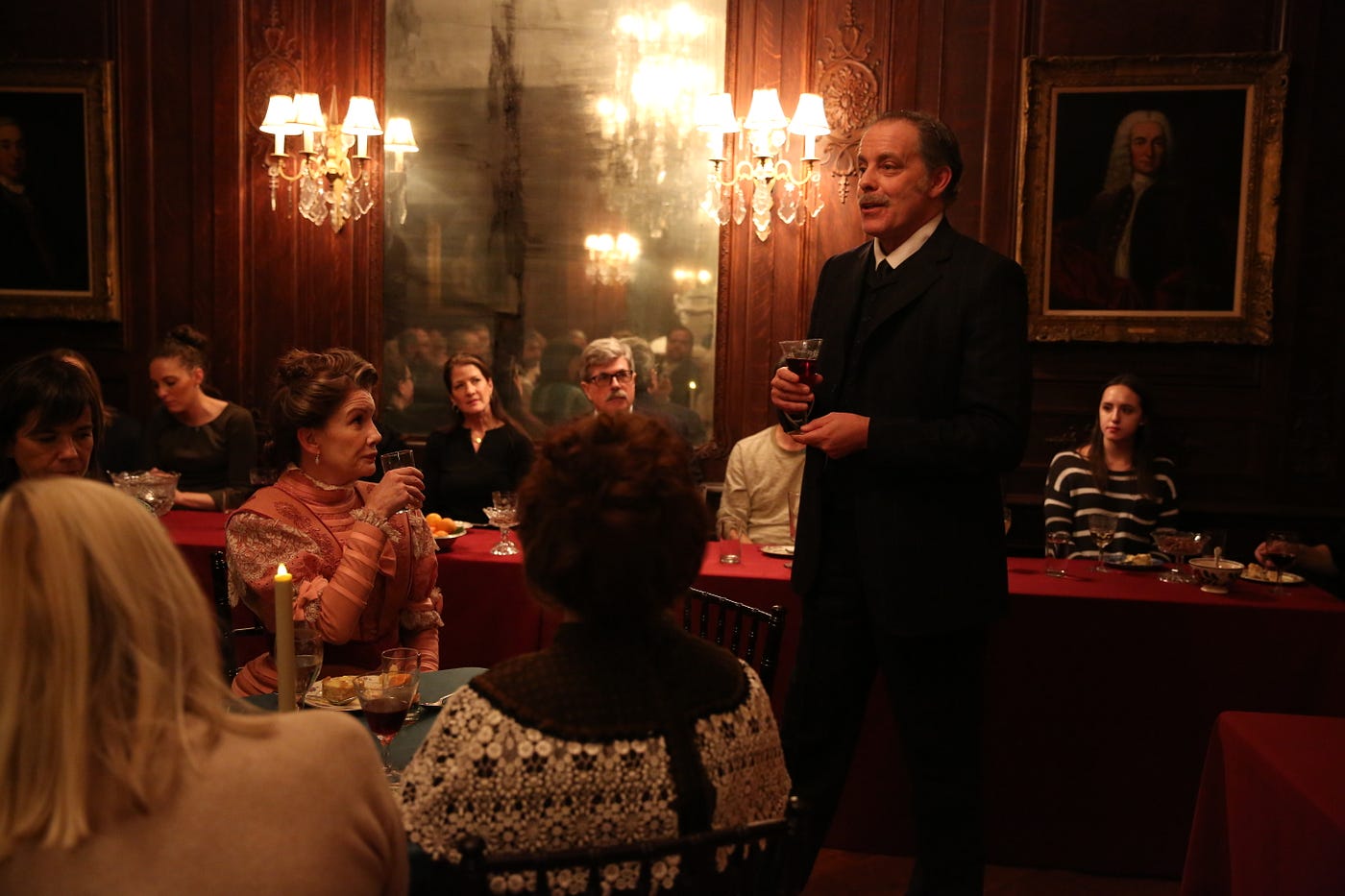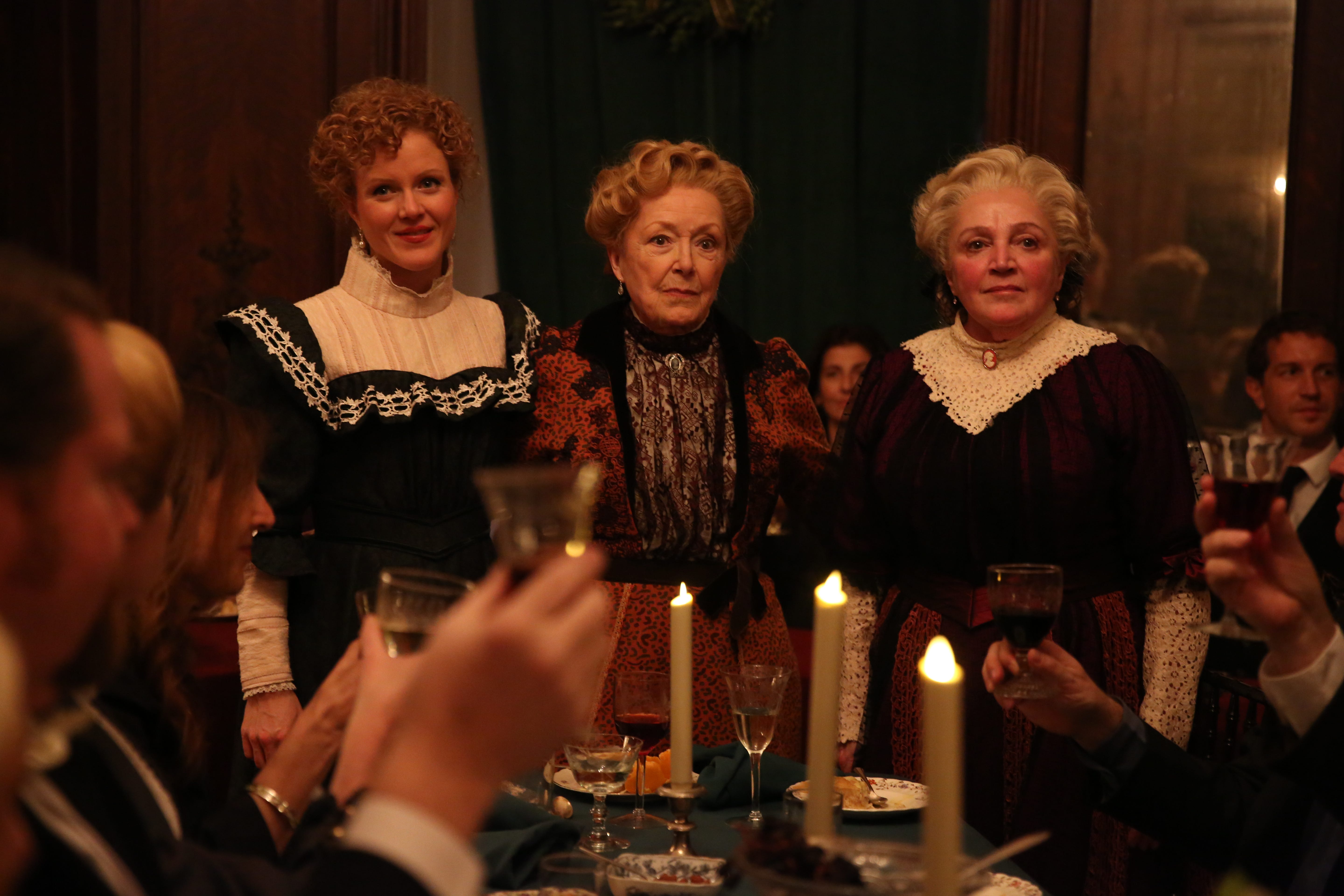
Be transported back to the world of James Joyce with The Irish Repertory Theater, American Irish Historical Society, and Dot Dot Productions
Having made our way down 5th Avenue, my partner and I are let into a warmly lit waiting area by a well-dressed doorman. After some gentle small talk with the other guests next to a tall Christmas tree, a mousey looking maid in full black and white attire scurries down the marble staircase. She introduces herself as Lily, the housemaid for the Morkans, and couple by couple, she asks if we are ready to come in. As we head up the stairs, the beautiful sounds of an old Irish melody are being played to us by a well-dressed lady playing the violin. As other couples gather around us, we are offered a variety of drinks (I chose a cozy warm apple cider), and other members of the household present us with musical offerings around the family piano.
The Dead, 1904 is the latest production by the Irish Repertory Theatre, which is an immersive take on James Joyce’s short story of the same name. Despite my English teacher’s best efforts, I had no connection to Joyce or this story prior to entering this production, and so I was eager to be a part of this spectacle.
Once we the audience are set in place around this impromptu concert, a doorbell sounds from downstairs. Our hosts for the evening, two well-dressed elderly ladies, Aunts Kate and Julia Morkin, create a small commotion as to whether this would be their nephew, Gabriel Conroy (or ‘Con-uh-roy’ as mispronounced by Lily the maid), finally coming home to visit them. The two aunts are gracious hosts, welcoming every invitee to the evening. Gabriel eventually arrives, complaining of the snow which slowed his progress as he takes off his leather galoches. A whole plethora of guests make their presence known within of the semi-circle that we as a concert audience had created, each greeting each other and congratulating themselves on the year so far. We meet characters like Bartell D’Arcy, a local opera star; Molly Ivors, an empowered female university lecturer; and Mr Browne, the scandalous Protestant of the all-Catholic town. This is clearly a high society dinner that we are attending tonight.
At one point in the proceedings, we are all ushered into the dining room for a celebratory dinner by Lily. A table is set for the main family members in the center of the room, while long community style tables are set around the edges of the room for the rest of us. We are served turkey and beef, identical to that of the center table, with a selection of sides being passed along the table from either side. As we quietly tuck in to dinner, the conversation at the “grown up” table continues, and we are invited to listen in.

As a thoroughly British desert of bread and butter pudding is served, Gabriel who has reappeared, delivers an after dinner speech, praising the affable hosts, while touching on the sad memories that sometimes linger; he notes that we must be grateful for our present and those that we love around us. He remarks
“The tradition of genuine warm-hearted courteous Irish hospitality, which our forefathers have handed down to us and which we in turn must hand down to our descendants, is still alive among us.”
The story, as you may have gathered, is a meandering, genteel narrative — a peek into the life of the upper middle class at the turn of the 20th century in Ireland. In some ways everything we hear from the guests is very surface level, with all persons being on their best behavior. It is only after the majority of the guests have decided to leave that we catch a glimpse of the real people at the dinner party. We follow Gabriel and his wife to the guest bedroom where they are staying for the night. This is the only scene not to take place in the warmly lit dining room/foyer; the cold bedroom which feels far more intimate and is suitable for the nature of the final act. The Dead, 1904 suddenly hits us with emotional weight and sobriety as Gabriel muses on the thoughts of mortality and memory. A surprise reveal feels less shocking than I’m sure it did in James Joyce’s day, but the emotion is tangible nonetheless. The final scene is a beautiful melancholy scene that left me wanting to learn more about the man that I had only just met.
Get Edward Mylechreest’s stories in your inbox
Join Medium for free to get updates from this writer.
SubscribeSubscribe
Paradoxically, whilst the play feels relatively slow by today’s standards, the text feels like it flies by at lightning pace. The production uses much of the original Joyce text, complete with all the Irish affectations that comes with it. I must admit, that even for this Briton, it was at times quite difficult to follow the dated text. While very little “action” happens in the narrative, it is easy to be somewhat confused by what is going on, with a dozen characters present at this soiree and very little introduction as to who is who, or how they know each other. It was not until the seated dinner portion of the evening that my partner and I were able to deduce what was going on. (Perhaps if I’d had a greater connection to the original Joyce story then this would have been straight forward, but this was perhaps an unnecessary barrier to being truly involved with the production.)
The venue, the American Irish Historical Society, really is a character in and of itself. The beautiful marble, traditional paintings, and humongous ceilings help transport us to the world of Joyce’s play. It is not hard to be swept away to an Irish Christmas from a hundred years ago. My girlfriend and I, both of us in our mid-twenties, were by far the youngest members of the audience, with a sea of silver-haired patrons enjoying the performance that we attended, which I am lead to believe is common for this production (due in part i’m sure to the ticket price for entry, starting at $150 for show-only tickets: a row of seats is left without food, awkwardly positioned behind those of us eating). The nature of the play, speaking to the Irish heritage of many New Yorkers, has helped to maintain a large pool of audience members.

From an immersive standpoint, The Dead, 1904 is quite light on its immersive fare. We are invited to watch the proceedings of the evening, to be witness to the comings and goings of the guests, but not to truly interact with them. For those willing to pay for the highest level of tickets ($1000 a person), places are set for you to join the cast of characters at the center dinner table. Through the rest of the evening, pseudo-prosceniums are created as the audience are moved and herded in such a way as to best spread them out to surround the performance. During the final act, taking place in a seperate bedroom, seats have been laid out in rows for the audience. As for the role of the audience, we are simply guests at this Christmas party, occasionally referred to as students of Miss Mary Jane, the music teacher, although this is not really expanded upon. The main cast of characters do not truly interact with us as “guests,” so this role feels somewhat forced upon us.
That said, the guests to either side of us during the dinner portion were overjoyed at the novelty of the evening, and seemed amazed at this new initiative that was presented to them. I observed more than one older woman singing along with the Irish melodies, presumably because they had learnt them from their own families. The Dead, 1904 is more than dinner theater, and although it did not live up to my own expectations, I could not help but be charmed by the piece.
For an audience of older patrons, who may not have encountered immersive work before, I presume this may have been precisely the level of immersive-ness that they were looking for. As amazing as a show like Sleep No More is, it is not necessarily designed for an older generation to enjoy. With fast-paced chases, a lot of standing and movement, and perhaps a raunchier evening than might have been expected, it may not be suitable for more senior guests. By contrast, The Dead, 1904, with its beautiful setting, non-confrontational subject matter, and well-known source material (to a particular demographic) has been tempered into an immersive experience, one which I believe has been tailored for the specific audience in mind.
As immersive theatre continues to grow and expand, it is not a bad thing to reflect upon the work of the past, and to recognise that there is a bigger audience than the hip 20-something crowd. Work has to be created with accessibility in mind and cater to the wants and needs of different generations. At this show, I was pleased to see room full of patrons leaving delighted from their brief immersive escapade, with the thought this may act as a catalyst for further exploration.
The Dead, 1904 is wonderfully quaint, which I do mean as a positive here, and thrives at transporting its audience into its world. While it may not be the most ambitious piece of immersive theatre, for those in attendance, it gives time to pause and reflect on our own histories, our own stories, and to consider our impact on those who we have loved before.
The Dead, 1904 continues at the Irish Historial Society through January 13, 2019. Tickets are $150–1000.
NoPro is a labor of love made possible by our generous Patreon backers: join them today!
In addition to the No Proscenium web site, our podcast, and our newsletters, you can find NoPro on Twitter, Facebook, YouTube, Instagram, in the Facebook community Everything Immersive, and on our Slack forum.















Discussion